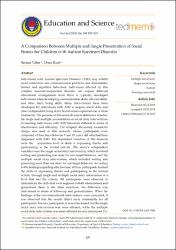| dc.contributor.author | Talas, Sertan | |
| dc.contributor.author | Kurt, Onur | |
| dc.date.accessioned | 2019-10-19T21:03:14Z | |
| dc.date.available | 2019-10-19T21:03:14Z | |
| dc.date.issued | 2019 | |
| dc.identifier.issn | 1300-1337 | |
| dc.identifier.uri | https://dx.doi.org/10.15390/EB.2019.7984 | |
| dc.identifier.uri | https://hdl.handle.net/11421/15491 | |
| dc.description | WOS: 000477865600014 | en_US |
| dc.description.abstract | Individuals with Autism Spectrum Disorder (ASD) may exhibit social interaction and communication problems and demonstrate limited and repetitive behaviors. Individuals affected by this complex neurodevelopmental disorder can require different educational arrangements from those of typically developed individuals when developing communication skills, self-care skills, and other daily living skills. Many interventions have been developed for individuals with ASD to acquire social skills and other independent living skills. Social stories represent one of these treatments. The purpose of this research was to determine whether the single and multiple presentations of social story interventions in teaching individuals with ASD behaviors differed in terms of effectiveness and efficiency. The adapted alternating treatments design was used in this research, whose participants were composed of four boys between 9 and 17 years old who had been diagnosed with ASD. The dependent variables of this research were the acquisition level of skills of expressing thanks and participating in the invited activity. The study's independent variables were the single social story intervention, which involved writing and presenting one story for one target behavior, and the multiple social story intervention, which included writing and presenting more than one story for one target behavior. According to the findings regarding effectiveness, all four participants learned the skills of expressing thanks and participating in the invited activity through single and multiple social story intervention at a level that met the criteria. All participants were observed to demonstrate the skills that were acquired in both interventions and generalized them to the other situations. No difference was determined in terms of follow-up and generalization. When the findings of the two instructional interventions were compared, it was observed that the results didn't recur consistently for all participants. For two participants, it was determined that the single social story intervention was more efficient, while the multiple social story intervention was more efficient for one participant. For the other participants, two instructional interventions were found to be equally efficient. In this study, data about social validity were gathered from participants, their parents, and their teachers. The findings regarding social validity showed that the participants, their parents, and their teachers expressed positive opinions about the study. | en_US |
| dc.language.iso | eng | en_US |
| dc.publisher | Turkish Education Assoc | en_US |
| dc.relation.isversionof | 10.15390/EB.2019.7984 | en_US |
| dc.rights | info:eu-repo/semantics/openAccess | en_US |
| dc.subject | Multiple Social Story | en_US |
| dc.subject | Single Social Story | en_US |
| dc.subject | Autism | en_US |
| dc.subject | Teaching Social Skill | en_US |
| dc.title | A Comparison Between Multiple and Single Presentation of Social Stories for Children with Autism Spectrum Disorder | en_US |
| dc.type | article | en_US |
| dc.relation.journal | Eğitim ve Bilim-Education and Science | en_US |
| dc.contributor.department | Anadolu Üniversitesi, Engelliler Araştırma Enstitüsü | en_US |
| dc.identifier.volume | 44 | en_US |
| dc.identifier.issue | 199 | en_US |
| dc.identifier.startpage | 297 | en_US |
| dc.identifier.endpage | 319 | en_US |
| dc.relation.publicationcategory | Makale - Uluslararası Hakemli Dergi - Kurum Öğretim Elemanı | en_US] |


















